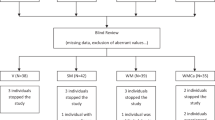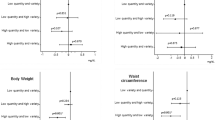Abstract
Background/Objectives:
Walnuts have been shown to reduce serum lipids in short-term well-controlled feeding trials. Little information exists on the effect and sustainability of walnut consumption for longer duration in a free-living situation.
Subjects/Methods:
A randomized crossover design in which 87 subjects with normal to moderate high plasma total cholesterol were initially assigned to a walnut-supplemented diet or habitual (control) diet for a 6-month period, then switched to the alternate dietary intervention for a second 6-month period. Each subject attended seven clinics 2 months apart. At each clinic, body weight was measured, and in five clinics (months 0, 4, 6, 10 and 12), a blood sample was collected.
Results:
Our study showed that supplementing a habitual diet with walnuts (12% of total daily energy intake equivalent) improves the plasma lipid profile. This beneficial effect was more significant in subjects with high plasma total cholesterol at baseline. Significant changes in serum concentrations of total cholesterol (P=0.02) and triglycerides (P=0.03) were seen and nearly significant changes in low-density lipoprotein cholesterol (LDL-C) (P=0.06) were found. No significant change was detected in either high-density lipoprotein (HDL) cholesterol LDL to HDL ratio.
Conclusions:
Including walnuts as part of a habitual diet favorably altered the plasma lipid profile. The lipid-lowering effects of walnuts were more evident among subjects with higher lipid baseline values, precisely those people with greater need of reducing plasma total and LDL-C.
This is a preview of subscription content, access via your institution
Access options
Subscribe to this journal
Receive 12 print issues and online access
$259.00 per year
only $21.58 per issue
Buy this article
- Purchase on Springer Link
- Instant access to full article PDF
Prices may be subject to local taxes which are calculated during checkout

Similar content being viewed by others
References
Abbey M, Noakes M, Belling GB, Nestel PJ (1994). Partial replacement of saturated fatty acids with almonds or walnuts lowers total plasma cholesterol and low-density-lipoprotein cholesterol. Am J Clin Nutr 59, 995–999.
Almario RU, Vonghavaravat V, Wong R, Kasim-Karakas SE (2001). Effects of walnut consumption on plasma fatty acids and lipoproteins in combined hyperlipidemia. Am J Clin Nutr 74, 72–79.
Banel DK, Hu FB (2009). Effects of walnut consumption on blood lipids and other cardiovascular risk factors: a meta-analysis and systematic review. Am J Clin Nutr 90, 56–63.
Dreaon DM, Vranzian KM, Krauss RM, Austin MA, Wood PD. (1990). The effects of polyunsaturated fat vs monounsaturated fat on plasma lipoproteins. J Am Med Assoc 263, 2462–2466.
Food and Drug Administration (2003). Qualified Health Claims: Letter of Enforcement Discretion—Nuts and Coronary Heart Disease (Docket No 02P-0505). http://www.fda.gov/Food/LabelingNutrition/LabelClaims/QualifiedHealthClaims/ucm072926.htm (accessed on 24 August 2009).
Fraser GE, Sabaté J, Beeson WL, Strahan TM (1992). A possible protective effect of nut consumption on risk of coronary artery disease: the adventist health study. Arch Intern Med 152, 1416–1424.
Ginsberg HN, Barr SL, Gilbert A, Karmally W, Deckelbaum R, Kaplan K et al. (1990). Reduction of plasma cholesterol levels in normal men on an American Heart Association Step 1 diet or a Step 1 diet with added monounsaturated fat. N Engl J Med 322, 574–579.
Hodson L, Skeaff CM, Chisholm WL. (2001). The effect of replacing dietary saturated fat with polyunsaturated or monounsaturated fat on plasma lipids in free-living young adults. Eu J Clin Nutr 55, 908–915.
Hu FB, Stampfer MJ, Manson JE, Rimm EB, Colditz GA, Rosner BA (1998). Frequent nut consumption and risk of coronary heart disease in women: prospective cohort study. Br Med J 317, 1341–1345.
Hu FB, Stampfer MJ (1999). Nut consumption and risk of coronary heart disease: a review of epidemiologic evidence. Curr Atheroscler Rep 1, 205–210.
Iwamoto M, Imaizumi K, Sato M, Hirooka Y, Sakai K, Takeshita A et al. (2002). Serum lipid profiles in Japanese women and men during consumption of walnuts. Eur J Clin Nutr 56, 629–637.
Kushi LH, Folsom AR, Prineas RJ, Mink PJ, Wu Y, Bostick RM (1996). Dietary antioxidant vitamins and death from coronary heart disease in postmenopausal women. N Engl J Med 334, 1156–1162.
Lohman TG, Roche AF, Martorell R (1991). Anthropometric Standardization Reference Manual Champaign. Human kinetics: IL. (abridged ed).
Morgan JM, Horton K, Reese D, Carey C, Walker K, Capuzzi DM (2002). Effects of walnut consumption as part of a low-fat, low-cholesterol diet on serum cardiovascular risk factors. Int J Vitam Nutr Res 72, 341–347.
Rose HG, Oklander M (1965). Improved procedure for the extraction of lipids from human erythrocytes. J Lipid Res 6, 428–431.
Sabaté J, Cordero-MacIntyre Z, Siapco G, Torabian S, Haddad E (2005). Does regular walnut consumption lead to weight gain? Br J Nutr 94, 859–864.
Sabaté J, Fraser GE, Burke K, Knutsen SF, Bennett H, Lindsted KD (1993). Effects of walnuts on serum lipids levels and blood pressure in normal men. N Engl J Med 328, 603–607.
Sabaté J, Fraser GE (1994). Nuts: a new protective food against coronary heart disease. Curr Opin Lipidol 5, 11–16.
Spiller GA, Jenkins DJA, Bosello O, Gates JE, Cragen LN, Bruce B (1998). Nuts and plasma lipids: an almond-based diet lowers LDL-C while preserving HDL-C. J Am Coll Nutr 328, 603–607.
Tapsell LC, Batterham MJ, Teuss G, Tan SY, Dalton S, Quick CJ et al. (2009). Long-term effects of increased dietary polyunsaturated fat from walnuts on metabolic parameters in type II diabetes. Eur J Clin Nutr 63, 1008–1015.
Tapsell LC, Gillen LJ, Patch CS, Batterham M, Owen A, Bare M et al. (2004). Including walnuts in a low-fat/modified-fat diet improves HDL cholesterol-to-total cholesteroal ratios in patients with type 2 diabetes. Diabetes Care 27, 2777–2783.
US Department of Health and Human Services and US Department of Agriculture (2005). Dietary Guidelines for Americans, 2005. 6th Edition US Government Printing Office: Washington, DC, 26.
Watkins SM, Lin TY, Davis RM, Ching JR, DePeters EJ, Halpern GM et al. (2001). Unique phospholipid metabolism in mouse heart in response to dietary docosahexaenoic or α-linolenic acids. Lipids 36, 247–254.
Zambón D, Sabaté J, Muñoz S, Campero B, Casals E, Merlos M et al. (2000). Substituting walnuts for monounsaturated fat improves the serum lipid profile of hypercholesterolemic men and women: a randomized crossover trial. Ann Intern Med 132, 538–546.
Zibaeenezhad MJ, Shamsnia SJ, Khorasani M (2005). Walnut consumption in hyperlipidemic patients. Angiology 56, 581–583.
Acknowledgements
This study was financed by California Walnut Commission. Setareh Torabian was the recipient of a scholarship from the California Walnut Commission during the execution of this research study.
Author information
Authors and Affiliations
Corresponding author
Rights and permissions
About this article
Cite this article
Torabian, S., Haddad, E., Cordero-MacIntyre, Z. et al. Long-term walnut supplementation without dietary advice induces favorable serum lipid changes in free-living individuals. Eur J Clin Nutr 64, 274–279 (2010). https://doi.org/10.1038/ejcn.2009.152
Received:
Revised:
Accepted:
Published:
Issue Date:
DOI: https://doi.org/10.1038/ejcn.2009.152
Keywords
This article is cited by
-
Dietary walnut oil modulates liver steatosis in the obese Zucker rat
European Journal of Nutrition (2014)
-
Homonymy, synonymy and hybrid misassignments in butternut (Juglans cinerea) and Japanese walnut (Juglans ailantifolia) nut cultivars
Genetic Resources and Crop Evolution (2012)
-
Characterizing the walnut genome through analyses of BAC end sequences
Plant Molecular Biology (2012)
-
Effects of different forms of hazelnuts on blood lipids and α-tocopherol concentrations in mildly hypercholesterolemic individuals
European Journal of Clinical Nutrition (2011)
-
Effect of moderate walnut consumption on lipid profile, arterial stiffness and platelet activation in humans
European Journal of Clinical Nutrition (2011)



